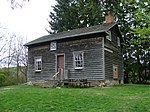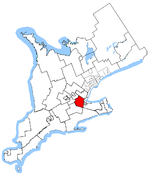Dundas Valley Conservation Area
Conservation areas in OntarioDundas, OntarioNature centres in OntarioNiagara EscarpmentProtected areas of Hamilton, Ontario

Dundas Valley Conservation Area is located on the Niagara Escarpment in Dundas, Ontario, a constituent community of Hamilton, Ontario, and is owned and operated by the Hamilton Conservation Authority. Its 40-kilometre trail system provides a connection to the Bruce Trail. The area contains a trailhead of the Hamilton-Brantford-Cambridge Trails, Canada's first fully developed interurban multi-use trail system, which is a part of the Trans Canada Trail.
Excerpt from the Wikipedia article Dundas Valley Conservation Area (License: CC BY-SA 3.0, Authors, Images).Dundas Valley Conservation Area
Main Loop (Bruce Trail), Hamilton Ancaster
Geographical coordinates (GPS) Address Nearby Places Show on map
Geographical coordinates (GPS)
| Latitude | Longitude |
|---|---|
| N 43.2375 ° | E -79.993888888889 ° |
Address
Main Loop (Bruce Trail)
Main Loop (Bruce Trail)
L9G 1L8 Hamilton, Ancaster
Ontario, Canada
Open on Google Maps





